Introduction to the Upanishads
The Upanishads are a collection of ancient Indian spiritual texts that form the philosophical backbone of Hinduism. Regarded as the final part of the Vedas (Vedanta), these scriptures delve into profound metaphysical questions about life, consciousness, the universe, and the ultimate reality — Brahman. The term “Upanishad” translates to “sitting down near”, indicating a sacred dialogue between a guru (teacher) and a disciple.
While the Vedas focus largely on rituals and hymns, the Upanishads represent a shift from ritualism to philosophical inquiry. They emphasize knowledge (Jnana), meditation (Dhyana), and inner realization (Atma-Vidya) over external worship.
History and Compilation
There are over 200 known Upanishads, of which 12–13 are considered principal or “Mukhya Upanishads.” These core texts were composed between 800 BCE and 200 BCE, mostly in Sanskrit. Key Upanishads include:
These texts are appended to the four Vedas — Rigveda, Samaveda, Yajurveda, and Atharvaveda — and mark the transition from the Vedic ritualistic worldview to introspective, philosophical spirituality.
Central Teachings of the Upanishads
1. Brahman – The Ultimate Reality
One of the key concepts in the Upanishads is Brahman, the infinite, formless, and eternal cosmic spirit. It is beyond time, space, and causation — the source of everything. It is neither male nor female, and beyond all dualities.
“Sarvam Khalvidam Brahma” — All this is indeed Brahman (Chandogya Upanishad)
2. Atman – The Inner Self
The Atman is the inner soul or the true self of every individual. It is eternal, unchanging, and identical with Brahman. The realization of the unity between Atman and Brahman is the highest spiritual goal.
“Aham Brahmasmi” — I am Brahman (Brihadaranyaka Upanishad)
3. Moksha – Liberation
Moksha or liberation is achieved through self-knowledge (Atma-Jnana), not through rituals. It is the release from the cycle of birth and death (samsara) and union with Brahman.
4. Karma and Rebirth
The Upanishads elaborate on the law of karma, stating that every action has consequences. This karmic cycle determines rebirths until liberation is achieved.
5. Meditation and Inner Realization
The path to liberation includes deep meditation, contemplation, and withdrawal from material distractions to focus on the Self.
Influence on Indian Philosophy
The Upanishads laid the groundwork for major Indian philosophies such as:
- Vedanta (especially Advaita Vedanta)
- Samkhya
- Yoga
- Bhakti movements
Philosophers like Adi Shankaracharya provided commentaries on key Upanishads and established non-dualism (Advaita), which asserts that Atman and Brahman are one.
Impact on Global Thought
The Upanishads have influenced Eastern and Western thinkers alike:
- Swami Vivekananda popularized their teachings globally during the 1893 Parliament of Religions.
- Arthur Schopenhauer called the Upanishads “the most rewarding and elevating reading possible.”
- Aldous Huxley, T.S. Eliot, and Carl Jung drew inspiration from Upanishadic concepts.
- The Transcendentalist movement in America, led by Ralph Waldo Emerson and Henry David Thoreau, was deeply influenced by these texts.
Upanishads in Modern Times
Today, the Upanishads are studied globally for their spiritual depth and universal wisdom. They offer guidance for:
- Mindfulness and meditation
- Understanding the self
- Living with ethical awareness
- Finding inner peace beyond materialism
In modern Yoga and wellness practices, the Upanishadic emphasis on introspection, detachment, and inner awareness is central.
Famous Quotes from the Upanishads
- “Tat Tvam Asi” – You are That (Chandogya Upanishad)
– Declares the identity of the self (Atman) with the ultimate reality (Brahman)
- “Neti Neti” – Not this, Not this (Brihadaranyaka Upanishad)
– Describes Brahman as beyond all material definitions
- “Yatra naryastu pujyante ramante tatra devata” – Where women are worshipped, there the gods dwell (Taittiriya Upanishad)
Structure and Style
Unlike epic narratives like the Mahabharata or Ramayana, the Upanishads are structured as dialogues, poetic verses, and philosophical prose. They often take the form of debates, introspections, or teachings between:
- A guru and disciple
- A father and son
- A king and sage
- Even death and a young seeker (as in the Katha Upanishad)
This dialogic method fosters deep reflection and personal realization.
Preservation and Translation
The first European translation of the Upanishads was done by Dara Shikoh (Mughal prince) in the 17th century. Later, Anquetil Duperron translated them from Persian to Latin, making them accessible to Western academia.
Today, multiple translations exist by scholars such as:
- Swami Sivananda
- Eknath Easwaran
- S. Radhakrishnan
- Patrick Olivelle
External Resources for Further Reading
- Sacred Texts Archive – Upanishads (English Translation)
A large collection of English translations of various Upanishads from the Internet Sacred Text Archive. - Vedanta Society – Teachings of the Upanishads
Summary and explanations from the Vedanta Society of Southern California.
Conclusion
The Upanishads are timeless treasures of Indian spiritual heritage. Their insights transcend religious boundaries, offering a universal path to inner awakening and liberation. Whether you’re a seeker of truth, a student of philosophy, or simply curious about ancient wisdom, the Upanishads provide a profound guide to life’s deepest questions.
Their core teaching — that the divine resides within us — remains as relevant today as it was thousands of years ago.
“Know thyself and you shall know the universe.”
FAQ – Frequently Asked Questions
Q1. What is the meaning of the word Upanishad?
It means “sitting near,” referring to the intimate transmission of spiritual knowledge from teacher to student.
Q2. How many Upanishads are there?
There are over 200 Upanishads; 12–13 are considered the principal Upanishads.
Q3. Who wrote the Upanishads?
They are mostly anonymous, attributed to ancient Indian sages and seers.
Q4. Are the Upanishads part of Hinduism?
Yes, they form the philosophical core of Hinduism and are the concluding part of the Vedas.
Q5. Can I read the Upanishads today?
Yes, there are many translated versions available in English and other languages.


Pingback:उपनिषद शब्द का अर्थ, उपनिषद का रचनाकाल, मुख्य उपनिषद् कितने है, उपनिषदों का महत्व - वैदिक सनातन